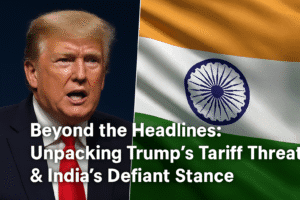Beyond the Headlines: Unpacking Trump’s Tariff Threat & India’s Defiant Stance
Former President Trump’s abrupt threat to impose 50% tariffs on Indian goods within 24 hours, explicitly targeting India’s purchase of discounted Russian oil as “fueling the war machine,” has dramatically escalated trade tensions. Simultaneously, the current White House signaled potential revisions to this drastic measure if significant foreign retaliation occurs, revealing a reactive strategy.
India forcefully rejected the threat as “unjustified,” defending its energy imports as essential for the security of its 1.4 billion citizens and driven by market realities and national interest, highlighting similar actions by other nations.
This clash transcends Trump’s longstanding complaints about trade imbalances, becoming a critical test of US sanctions enforcement versus India’s strategic autonomy and need for affordable energy. India’s defiant stance, echoed domestically by PM Modi’s vow to protect citizens and calls for self-reliance, underscores hardening sentiment against perceived US unilateralism. Crucially, despite the heated rhetoric, a scheduled visit by US trade negotiators to Delhi on August 25th remains a pivotal diplomatic off-ramp. The outcome threatens the foundation of the broader US-India strategic partnership and raises profound questions about the global stability of trade when met with aggressive, unilateral economic force.

Beyond the Headlines: Unpacking Trump’s Tariff Threat & India’s Defiant Stance
The simmering trade tensions between the US and India escalated dramatically this week, revealing high-stakes economic diplomacy in action. Here’s a deeper dive into the unfolding situation:
The Flashpoint:
- Trump’s Ultimatum: Former President Donald Trump, in a CNBC interview, declared his intention to “substantially increase” tariffs on India “within 24 hours,” specifically targeting its purchase of Russian oil as “fueling the war machine.” This followed his recent announcement of 25% tariffs.
- The White House Gambit: Responding swiftly, current White House officials signaled that Trump’s proposed 50% tariff order could be revised if major trading partners enact significant retaliation. This reveals a calculated, potentially reactive strategy, acknowledging the risk of a damaging trade war.
- India’s Firm Rebuttal: India’s Ministry of External Affairs (MEA) labeled the threatened tariffs “extremely unfortunate” and “unjustified.” Crucially, they framed India’s energy imports as a non-negotiable matter of national security and market reality, essential for the well-being of its 1.4 billion citizens. They pointed out the perceived hypocrisy, noting similar actions by other nations.
Beyond the Brinkmanship: The Underlying Currents
- The Russia Factor: This isn’t just about trade deficits. Trump explicitly links the tariff threat to India’s continued purchases of discounted Russian oil, a critical revenue stream for Moscow. The US seeks to tighten the sanctions noose, while India prioritizes affordable energy and strategic autonomy.
- The “Fair Trade” Narrative: Trump resurrected his long-standing grievance about perceived imbalances (“India has not been a good trading partner”). The massive tariff hike leverages economic pressure to force concessions beyond just energy policy, potentially targeting market access or intellectual property issues.
- Domestic Resonance in India: India’s response resonates domestically. Prime Minister Modi’s vow to “pay a heavy price to protect farmers” and industrialist Anand Mahindra’s call to “make our own nation greater than ever” reflect a hardening stance against perceived US unilateralism. Investor warnings about the “gravity” of 50% tariffs highlight real economic anxiety.
- The Human Cost: While the article mentions impacts on Indian students, the potential ripple effects are vast. Businesses reliant on US-India trade face immense uncertainty; consumers in both countries could see price hikes; and vital sectors like pharmaceuticals, textiles, and IT services hang in the balance.
- The Diplomatic Tightrope: Despite the public clash, the scheduled visit of the US trade team to Delhi on August 25th is a crucial detail. It signals that channels remain open, and both sides recognize the need for negotiation, even amidst the harsh rhetoric. The White House’s openness to revision suggests a door is still ajar.
Why This Matters Now:
This isn’t merely a rerun of past trade spats. The confluence of factors – the Ukraine conflict, US election-year politics, India’s assertive global posture, and the sheer scale of the threatened tariffs (50%) – creates a uniquely volatile moment. The outcome will significantly impact:
- Global Energy Markets: Can the US effectively pressure major economies like India away from Russian oil?
- US-India Strategic Ties: Will economic friction damage the broader “Indo-Pacific partnership” both nations tout?
- Global Trade Stability: Does this signal a return to aggressive, unilateral tariff policies as a primary tool?
- Economic Security: How will businesses and citizens in both nations weather the potential storm?
The Path Ahead:
All eyes are now on two dates: the potential formalization of Trump’s 50% threat and, more critically, the August 25th negotiations. The White House’s conditional flexibility and India’s unwavering stance on energy security set the stage for intense diplomacy. Whether this crisis de-escalates or spirals depends on whether pragmatic negotiation can overcome public posturing and address the genuine, complex security and economic concerns on both sides. The stakes for the global economic order are undeniably high.
You must be logged in to post a comment.